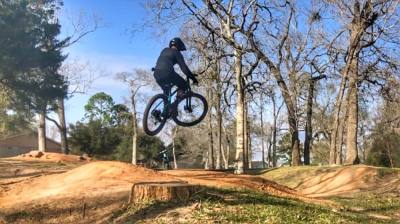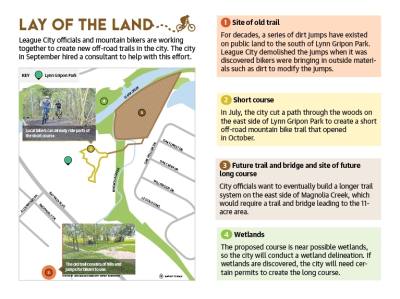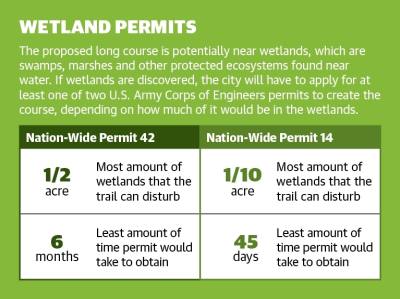Despite having to demolish jumps found to be illegal along one trail, the city is working with local mountain bikers to construct a short off-road course as well as a longer proposed course, all near Lynn Gripon Park at Countryside.
“It was complicated and contentious at first, but it opened a door to ... an exciting new addition to recreational activities,” Assistant City Manager Bo Bass said of the city and bikers working together.
Additionally, the city hired a consultant in September to update the city’s parks master plan with a mountain biking chapter and survey the city for other possible trail locations. By the time they are done, city officials said League City may have twice as many bike trails as it does today.
Rudy Culp is president of the newly formed nonprofit Clear Creek Off-Road Biking Association, which he formed with six other board members solely to help the city with the trails effort. Culp said League City’s tendency to flood makes mountain biking a challenge locally, but he is happy to see an effort being made.
“The idea is to build something ... fun and flowy but that everybody can use,” he said of the new courses. “I think we’re on the right track.”
Appeasing bikers
For decades, miles of dirt trails have existed on public land around Lynn Gripon Park. Residents have used them for years to walk and ride bikes, particularly mountain bikes, city officials and Culp said.
One section of the trails near the park’s concrete walking path and an adjacent neighborhood consists of a few dirt jumps. Dozens of young and experienced mountain bikers alike have found it to be one of the only League City locations where they can do what they love: ride and jump mountain bikes, Culp said.
However, problems arose around January when bikers began bringing outside elements, such as dirt and cinderblocks, to this section of the trail to build jumps. Bikers also widened paths and cut down trees in the area, city officials said.
Neighbors complained to the city early this year, leading to the city having to remove the jumps because such unpermitted modifications are not allowed in flood plains, where the trail sits.
“For years and years and years, people have enjoyed the trails, and that’s been great, but when we get a formal complaint, we have to go out and look at it,” Bass said. “These improvements are of a concern because they’re ... in flood plains.”
Because Lynn Gripon Park is in Clear Creek’s 100-year flood plain—an area predicted to flood during a storm that has a 1% chance of occurring annually—it is illegal to make unpermitted modifications to the land, such as bringing dirt in to make jumps. Several small changes can affect how water flows during floods, possibly directing floodwaters to neighbors’ properties, League City Engineering Director Chris Sims said.
“A little here, a little there—it all adds up,” he said.
After demolishing the jumps, staff erected signs warning residents to not modify trails or face possible prosecution. Bikers complained the signs were too close to the trails. The city agreed and moved them out of the way, Bass said.
“That was the first step in developing a relationship of communication and coming to a common mind,” he said of the city’s effort to move the signs.
City officials said they understand bikers’ desire for a legitimate course, so in July, staff cut a path of trees down in a different area of the park, on the east side of Bay Area Boulevard. Culp and his fellow bikers have been working to make this “short course” a mountain bike path, but they still cannot add fill such as dirt to this area because it is in a flood plain, officials said.
Some members of Culp’s nonprofit said progress on the trail would be faster if the city did not have to approve the trail’s construction. Still, Culp said it is nice to see the city working to address bikers’ desires, especially as demand rises.
Billy Trant owns Friendswood Bicycle in Friendswood where he sells, repairs and builds different types of bikes. Trant said COVID-19 and high demand for bike parts have led to a material shortage affecting supplies.
“[Demand] is definitely increasing, and not just mountain biking,” he said. “The bike scene is definitely moving up.”
Another incoming trail
The 1/3-mile short course, which is under construction and set to be completed in the coming months at a cost of $1,300 to the city, is not the only cycling trail in the works.
The city wants to create an even longer course to the northeast of the short course. On an 11-acre plot, the course would travel along the east side of Magnolia Creek and require a bridge over Magnolia Creek, Parks Director Chien Wei said.
The project—originally estimated at $132,000—was initially approved in League City’s fiscal year 2019-20 budget but never came to fruition, so the city is working to include the project in the city’s FY 2022-23 budget, Wei said.
The trail would be permitted to include jumps and other elements bikers are missing out on due to the demolition of the old trail’s jumps. The problem is the site of the planned course is potentially in wetlands—swamps, marshes and other protected ecosystems near creeks and rivers—meaning there are certain channels the city has to go through to create the course, delaying its construction up to two years, Sims said.
“There’s some issues that need to be worked before the ... project can really move forward and get to construction,” he said.
The city must conduct a wetland delineation to determine if and where wetlands are located in the footprint of the potential trail. If wetlands are discovered, the city would have to acquire one of two U.S. Army Corps of Engineers permits to build a trail in the area.
Both permits would require the trail disturb less than 1/2 of an acre of wetlands. One permit would take about six months to obtain. However, if the city can reduce its disturbance to 1/10 of an acre of wetlands, the city could acquire a different permit that would take only about 45 days to obtain, Sims said.
City staff said they opted to create the short course because they knew it would take some time to make the longer trail.
The fact League City has to jump through hoops to create trails is not surprising. League City is located in a flood-prone area, and most of the city land that does not flood has already been developed, Culp said.
“This is not a great area for mountain bikes. It’s low; we’re at sea level,” he said. “Not a whole lot of elevation.”
Culp said local mountain bikers like to travel to places such as Sugar Land and Cypress, which are less flood-prone and have miles of off-road bike trails. Still, Culp said he appreciates League City’s effort to make the area mountain bike-friendly.
“I think we can make it something fun if they give us the right to do what we want to do,” he said of the incoming courses.
Future goals
The city’s long-term plan is to double the 21 miles of existing trails in the city, Bass said.
“The sky’s almost the limit in terms of how many additional miles of trails we can add,” he said.
League City City Council on Sept. 28 approved a $39,500 contract with engineering firm Halff Associates to provide mountain bike trail planning and design as well as maintenance recommendations for the city. Additionally, the group over the next four months will help the city develop a biking chapter in the city’s parks master plan to serve as the citywide guide for the design, implementation and maintenance of mountain bike trails in the city, according to League City documents.
Eventually, the old jumps and ramps League City demolished earlier this year could return, but they will come back legally, Bass said. Jumps could also be added to the short course under development, he said.
“It’s going to have hills; it’s going to have wobbles; and it’s going to have challenges of various kinds,” Bass said. “But that takes time.










